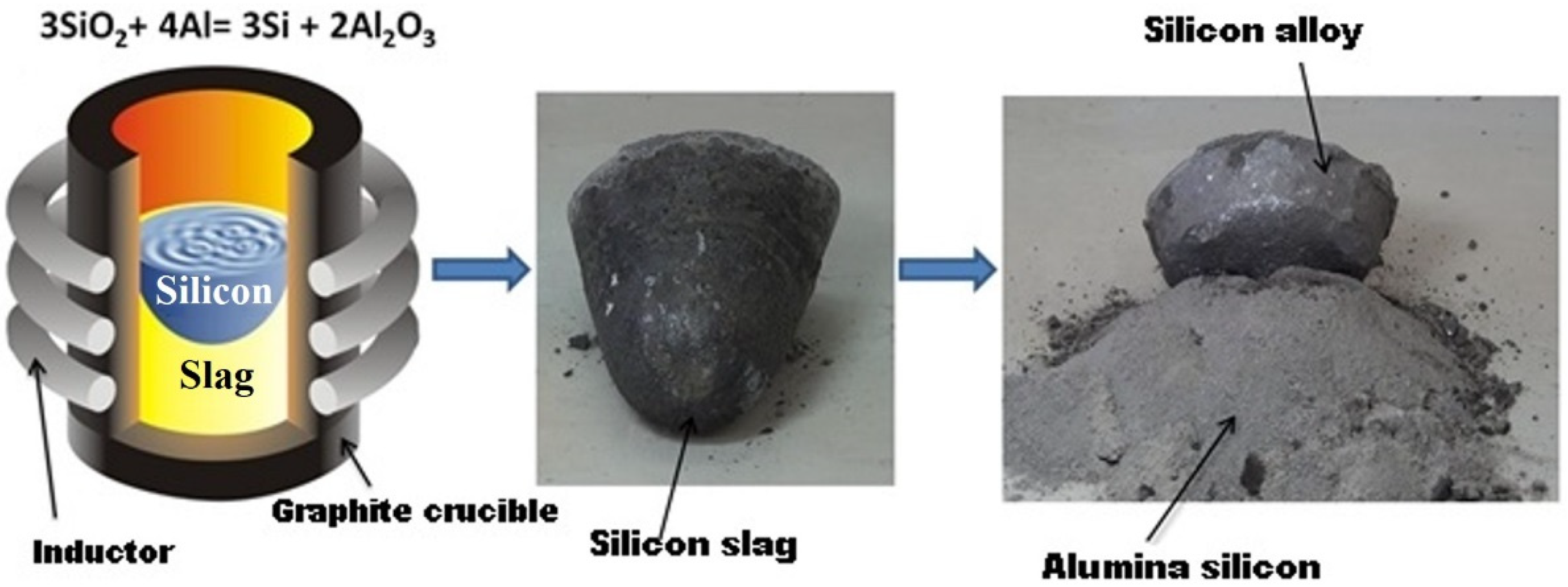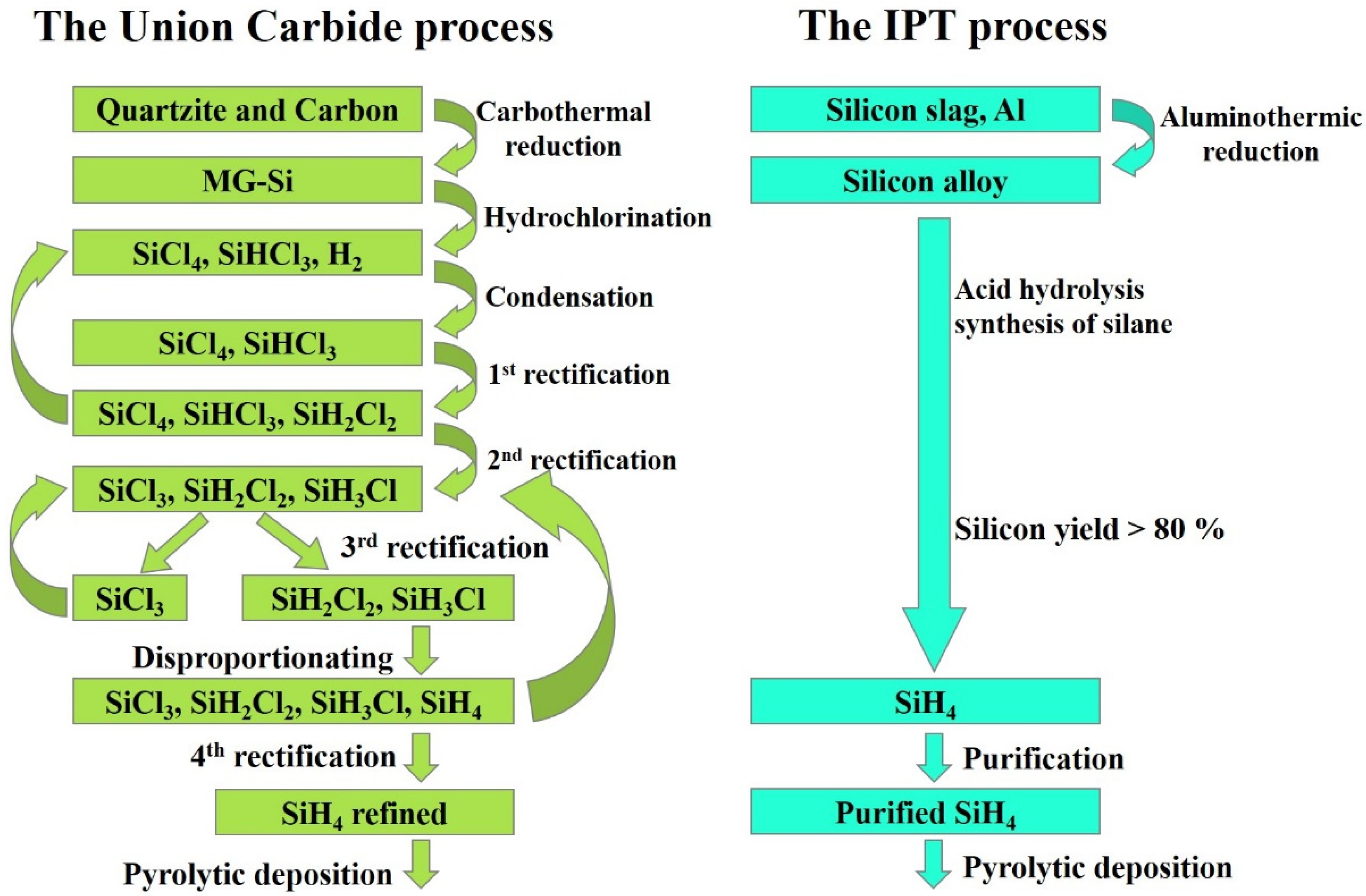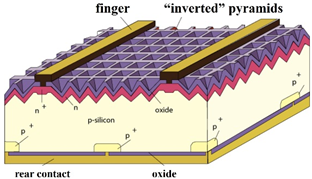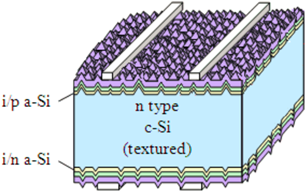Integration of Kazakhstan Technologies for Silicon and Monosilane Production with the Suitable World Practices for the Production of Solar Cells and Panels
Abstract
1. Introduction
- Wafer-based crystalline Si solar cells (made of monocrystalline Si, multi-crystalline Si, polycrystalline Si)—occupying 85–90% of the market; and
- Thin-film solar cells (made of amorphous Si, CdTe, CuInGaSe2 (CIGS) or CuInSe2 (CIS), GaAs/Ge, organic materials and organohalide perovskites)—occupying around 15–20% of the market.
2. Silicon Classification
- Metallurgical-grade silicon (MG-Si) is usually produced by carbothermic preparation. MG-Si is used in the iron and steel industry as the doping material and is the raw material for solar- and electrical-grade silicon.
- Solar-grade silicon (SoG-Si) is derived from MG-Si by its further purification and intended for use in SC.
- Electronic-grade silicon (EG-Si) used for the production of solid-state electronic devices, chips, etc.
3. Metallurgical-Grade Silicon
4. Upgraded Metallurgical-Grade Silicon
- Carbothermal reduction of quartz from selected raw materials to minimize the content of impurities; and
- Bucket refining using gas (or plasma) or slag.
5. Gaseous Silicon Compounds
6. Mono- and Polysilicon Ingots Production
7. Solar Cell Production
7.1. Amorphous Silicon Solar Cells
7.2. Silicon Hetero-Junction (HIT) Solar Cells
8. Solar Module Production
- Reduced shading of the face surface thanks to thin wires dozens of micrometers wide;
- Reduced quantity of required silver due to replacement with copper wires by 70%; and
- Up to 10% increased quantity of produced electricity without increasing the module cost.
9. Conclusions
Author Contributions
Funding
Conflicts of Interest
References
- Gielen, D.; Gorini, R.; Leme, R.; Prakash, G.; Wagner, N.; Janeiro, L.; Collins, S.; Kadir, M.; Asmelash, E.; Ferroukhi, R.; et al. Energy Transitions Outlook: 1.5 °C Pathway; International Renewable Energy Agency: Abu Dhabi, United Arab Emirates, 2021; Available online: http://www.irena.org/publications (accessed on 13 February 2022).
- Ssemombwe, R. Solar Power Production Efficiency. Ph.D. Thesis, Makerere University, Kampala, Uganda, 2021. [Google Scholar]
- Seo, B.; Kim, J.Y.; Chung, J. Overview of global status and challenges for end-of-life crystalline silicon photovoltaic panels: A focus on environmental impacts. Waste Manag. 2021, 128, 45–54. [Google Scholar] [CrossRef] [PubMed]
- Mukashev, B.; Abdullin, K.; Tamendarov, M.; Turmagambetov, T.; Beketov, B.; Page, M.; Kline, D. A metallurgical route to produce upgraded silicon and monosilane. Sol. Energy Mater. Sol. Cells 2009, 93, 1785–1791. [Google Scholar] [CrossRef]
- Mukashev, B.N.; Betekbaev, A.A.; Kalugulov, D.A.; Pellegrin, Y.; Skakov, D.M.; Turmagambetov, T.S. KAZPV PROJECT: Industrial development of a vertically integrated pv production in Kazakhstan (from guartz processing up to production high technology outputs). Rep. Natl. Acad. Sci. Repub. Kazakhstan 2013, 6, 5–19. [Google Scholar]
- Betekbaev, A.A.; Mukashev, B.N.; Pelissier, L.; Lay, P.; Fortin, G.; Bounaas, L.; Skakov, D.M.; Kalygulov, D.A.; Turmagambetov, T.; Lee, V.V. Comparison of the characteristics of solar cells fabricated from multicrystalline silicon with those fabricated from silicon obtained by the monolike technology. Semiconductors 2016, 50, 1085–1091. [Google Scholar] [CrossRef]
- Betekbaev, A.A.; Mukashev, B.N.; Pelissier, L.; Lay, P.; Fortin, G.; Bounaas, L.; Skakov, D.M.; Pavlov, A.A. Doping optimization of solar grade (SOG) silicon ingots for increasing ingot yield and cell efficiency. Mater. Electron. Engin. 2015, 18, 103–109. [Google Scholar] [CrossRef][Green Version]
- Kalygulov, D.; Klinovitskaya, I.; Turmagambetov, T.; Pavlov, A.; Plotnikov, S.; Mukashev, B.; Serikkanov, A.; Agabekov, Z.; Kantarbaeva, D. High-tech production of photo-energy in Kazakhstan based on the sarykol quartz deposit. Phys. Math. 2019, 3, 120–129. [Google Scholar] [CrossRef]
- May, J. Quartz (Silica) Mine: Technical Development History; Auzminerals resources Group Ltd.; Solar Silicon resources Group Pte Ltd.: Singapore, 2013. [Google Scholar]
- Philipsson, H.; Wallin, M.; Einarsrud, K.E.; Tranell, G. Kinetics of Silicon Production by Aluminothermic Reduction of Silica Using Aluminum and Aluminum Dross as Reductants. In Proceedings of the 16th International Ferro-Alloys Congress (INFACON XVI), Trondheim, Norway, 27–29 September 2021. [Google Scholar] [CrossRef]
- Khovaiter, S.A.; Chumikov, G.N.; Tamendarov, M.F.; Bekturganov, N.S.; Tokmoldin, N.S.; Tokmoldin, S.Z. A Method for Purifying Silicon, a Method for Separating It from Slag, A Method for Dispersing Lump Silicon into Powder and a Method for Purifying Impurities of Silicon Powder. Innovative Patent RK 26252, 15 October 2012. [Google Scholar]
- Guan, J.; Xie, K.; Liu, A.; Shi, Z.; Chen, G.; Boca, M. Study on the mechanism of Al-Si alloy preparation via aluminothermic reduction–molten salt electrolysis in KF–AlF3 molten salt. Mater. Today Commun. 2021, 29, 102959. [Google Scholar] [CrossRef]
- Mukashev, B.; Tamendarov, M.; Kikkarin, S.; Ustimenko, A. Development of a technology of silicon production by recycling phosphorous industry wastes. Sol. Energy Mater. Sol. Cells 2002, 72, 605–611. [Google Scholar] [CrossRef]
- Dietl, J.; Helmreich, D.; Sirtl, E. Solar silicon. In Silicon; Springer: Berlin/Heidelberg, Germany, 1981; pp. 43–107. [Google Scholar]
- Kurz, G.; Schwirtlich, I.; Gebauer, K. Process for Separating Impurities from Silicon. European Patent DE 3727647, 19 September 1987. [Google Scholar]
- Sirtl, E. Future trends in solar silicon production. Sol. Cells 1983, 10, 101–108. [Google Scholar] [CrossRef]
- Antonio, L.; Steven, H. Handbook of Photovoltaic Science and Engineering; Wiley: Hoboken, NJ, USA, 2003; p. 1138. [Google Scholar]
- Stanishevsky, M. We will make silicon. Chem. J. 2008, 9, 22–28. [Google Scholar]
- Forniés, E.; del Cañizo, C.; Méndez, L.; Souto, A.; Vázquez, A.P.; Garrain, D. UMG silicon for solar PV: From defects detection to PV module degradation. Sol. Energy 2021, 220, 354–362. [Google Scholar] [CrossRef]
- Bye, G.; Ceccaroli, B. Solar grade silicon: Technology status and industrial trends. Sol. Energy Mater. Sol. Cells 2014, 130, 634–646. [Google Scholar] [CrossRef]
- Yarkin, V.N.; Kisarin, O.A.; Rekov, Y.V.; Chervony, I.F. Silicon for solar energy: Technology competition, market impact, development problems. Theory Pract. Metall. 2010, 1, 114–125. [Google Scholar]
- Tamendarov, M.F.; Turmagambetov, T.S.; Beketov, B.A.; Abdullin, K.A.; Chumikov, G.N.; Mukashev, B.N. Silicon obtaining method. Kazakhstan Patent 22590, 15 June 2010. [Google Scholar]
- Pastor, V.E. Life Cycle Assessment of Silicon Metal by Aluminothermic Reduction: An Industrial Symbiosis Approach. Master’s Thesis, Norwegian University of Science and Technology, Trondheim, Norway, 2021. [Google Scholar]
- Tamendarov, M.F.; Mukashev, B.N.; Abdullin, K.A.; Kulekeev, K.; Bekturganov, N.S.; Beketov, B.A. Purified Silicon Obtaining Method. Kazakhstan Patent 17865, 12 October 2004. [Google Scholar]
- Tamendarov, M.F.; Tokmoldin, S.; Chumikov, G.N. Obtaining high-purity metallurgical silicon (UMG-Si) by the method of aluminothermy. In Proceedings of the Metallurgical Silicon—2012. Physicochemical processes and technologies for obtaining metallurgical silicon, Karaganda, Kazakhstan, 23–25 May 2012; pp. 182–185. [Google Scholar]
- DebRoy, T.; Bhadeshia, H.K.D.H. Inventions that enabled the silicon age. In Innovations in Everyday Engineering Materials; Springer: Cham, Switzerland; pp. 65–74. [CrossRef]
- Nie, Z.; Wang, Y.; Wang, C.; Guo, Q.; Hou, Y.; Ramachandran, P.A.; Xie, G. Mathematical model and energy efficiency analysis of Siemens reactor with a quartz ceramic lining. Appl. Therm. Eng. 2021, 199, 117522. [Google Scholar] [CrossRef]
- Campillo, J.; Foster, S. Global Solar Photovoltaic Industry Analysis with Focus on the Chinese Market; Malardalen University. Available online: http://mdh.divaportal.org/smash/get/diva2:127961/FULLTEXT01.pdf (accessed on 13 February 2022).
- Jarkin, V.N.; Kisarin, O.A.; Kritskaya, T.V. Methods of trichlorosilane synthesis for polycrystalline silicon production. Part 1: Hydrochlorination and redistribution. Mod. Electron. Mater. 2021, 7, 33–43. [Google Scholar] [CrossRef]
- Khattak, C.P. Silicon Processing for Photovoltaics I; Technology & Engineering: North-Holland, The Netherlands, 1985; Volume 1, p. 380. [Google Scholar]
- Culbertson, J.B. Method of Producing Silanes. U.S. Patent 2,551,571, 8 May 1951. [Google Scholar]
- Belot, D. Production of Silanes from Silicon Alloys and Alkaline Earth Metals or Alkaline Earth Metal Silicides. France Patent WO 2011/010032 A1, 27 January 2011. [Google Scholar]
- Tamendarov, M.F.; Turmagambetov, T.S.; Beketov, B.A.; Abdullin, K.A.; Chumikov, G.N.; Mukashev, B.N. Silane Obtaining Method. Kazakhstan Patent 20988, 16 March 2009. [Google Scholar]
- Tamendarov, M.F.; Mukashev, B.N.; Abdullin, K.A.; Kulekeev, K.; Bekturganov, N.S.; Beketov, B.A. Silane Obtaining Method. Kazakhstan Patent 17866, 12 October 2004. [Google Scholar]
- Nashelsky, A. Production of Semiconductor Materials; Metallurgy: Moscow, Russia, 1989; p. 272. [Google Scholar]
- Ren, J.-C.; Liu, D.; Wan, Y. Modeling and application of Czochralski silicon single crystal growth process using hybrid model of data-driven and mechanism-based methodologies. J. Process Control 2021, 104, 74–85. [Google Scholar] [CrossRef]
- Green, M.A. Crystalline Silicon Solar Cells; World Scientific: Singapore, 2001; Chapter 4; p. 49. [Google Scholar]
- Fahrenbruch, A.; Bube, R. Solar Cells: Theory and Experiment; Energoatomizda: Moscow, Russia, 1987; p. 280. [Google Scholar]
- Zhang, S.; Zhang, T.; Liu, Z.; Wang, J.; Yu, L.; Xu, J.; Cabarrocas, P.R. Highly flexible radial tandem junction thin film solar cells with excellent power-to-weight ratio. Nano Energy 2021, 86, 106121. [Google Scholar] [CrossRef]
- Enaganti, P.K.; Goel, S. Investigation of Silicon Solar Cells under Submerged Conditions with the Influence of Various Parameters: A Comparative Study. Energy Technol. 2021, 9, 2100018. [Google Scholar] [CrossRef]
- Afanasyev, V.P.; Terukov, E.I.; Sherchenkov, A.A. Thin-Film Solar Cells Based on Silicon. St. Petersburg State Electrotechnical University “LETI” Them. VI Ulyanov (Lenin); Ministry of Education and Science of Russia: Lenin, Russia, 2011. [Google Scholar]
- Zhang, C.; Zhang, J.; Ma, X.; Feng, Q. Thin-Film Solar Cells Based on Amorphous Silicon. Semiconductor Photovoltaic Cells; Springer: Berlin/Heidelberg, Germany, 2021; pp. 177–238. [Google Scholar]
- Gordijn, A. Microcrystalline Silicon for Thin-Film Solar Cells; Utrecht University: Utrecht, The Netherlands, 2005. [Google Scholar]
- Meier, J.; Dubail, S.; Golay, S.; Kroll, U.; Faÿ, S.; Vallat-Sauvain, E.; Shah, A. Intrinsic microcrystalline silicon (μc-Si:H)—A promising new thin film solar cell material. In Proceedings of the 24th IEEE Photovoltaic Specialists Conference, Waikoloa, HI, USA, 5–9 December 1994; pp. 409–412. [Google Scholar]
- Schropp, R.E.I.; Zeman, M. Amorphous and Microcrystalline Silicon Solar Cells: Modeling, Materials and Device Technology; Springer: Berlin/Heidelberg, Germany, 1998; p. 5. [Google Scholar]
- Meier, J.; Flückiger, R.; Keppner, H.; Shah, A. Complete microcrystalline p-i-n solar cell—Crystalline or amorphous cell behavior? Appl. Phys. Lett. 1994, 65, 860–862. [Google Scholar] [CrossRef]
- Pisminetsky, V.; Nevliudov, I.; Botsman, I.; Bortnikova, V.; Yevsieiev, V.; Mospan, D. Degradation and regeneration in silicon concentrator solar panels. In Proceedings of the IEEE International Conference on Modern Electrical and Energy Systems (MEES), Kremenchuk, Ukraine, 21–24 September 2021; pp. 518–521. [Google Scholar]
- Staebler, D.L.; Wronski, C.R. Reversible conductivity changes in discharge-produced amorphous Si. Appl. Phys. Lett. 1977, 31, 292–294. [Google Scholar] [CrossRef]
- Carlson, D.E.; Wronski, C.R. Amorphous silicon solar cell. Appl. Phys. Lett. 1976, 28, 671–673. [Google Scholar] [CrossRef]
- Benagli, S.; Borrello, D.; Vallat-Sauvain, E.; Meier, J.; Kroll, U.; Hötzel, J.; Bailat, J.; Steinhauser, J.; Marmelo, M.; Monteduro, G.; et al. High-efficiency amorphous silicon devices on LPCVD-ZnO TCO prepared in industrial KAI-M R&D reactor. In Proceedings of the 24th European Photovoltaic Solar Energy Conference, Hamburg, Germany, 21–25 September 2009; pp. 344–349. [Google Scholar]
- Sai, H. 11.0% -efficient thin-film microcrystalline silicon solar cells with honeycomb textured substrates. Photovolt. IEEE J. 2014, 4, 1349–1353. [Google Scholar] [CrossRef]
- Okil, M.; Salem, M.S.; Abdolkader, T.M.; Shaker, A. From crystalline to low-cost silicon-based solar cells: A review. Silicon 2021, 14, 1–17. [Google Scholar] [CrossRef]
- Matsui, T.; Sai, H.; Suezaki, T.; Matsumoto, M.; Saito, K.; Yoshida, I.; Kondo, M. Development of highly stable and efficient amorphous silicon based solar cells. In Proceedings of the 28th European Photovoltaic Solar Energy Conference and Exhibition, Paris, France, 30 September–4 October 2013; pp. 2213–2217. [Google Scholar]
- Veirman, J.; Varache, R.; Albaric, M.; Danel, A.; Guo, B.; Fu, N.; Wang, Y. Silicon wafers for industrial n-type SHJ solar cells: Bulk quality requirements, large-scale availability and guidelines for future developments. Sol. Energy Mater. Sol. Cells 2021, 228, 111128. [Google Scholar] [CrossRef]
- Street, R.A. Technology and applications of amorphous silicon. In Materials Science; Springer: Berlin/Heidelberg, Germany, 2000; p. 417. [Google Scholar]
- Van Cleef, M.W.; Rubinelli, F.A.; Rizzoli, R.; Pinghini, R.; Schropp, R.E.; Van der Weg, W.F. Amorphous silicon carbide/crystalline silicon heterojunction solar cells: A comprehensive study of the photocarrier collection. Jpn. J. Appl. Phys. 1998, 37, 3926–3932. [Google Scholar] [CrossRef]
- Pakala, P.S.A.; Pattnaik, A.; Tomar, A. Comprehensive study on heterojunction solar cell. In Machine Learning, Advances in Computing, Renewable Energy and Communication. Lecture; Springer: Singapore, 2022; pp. 543–552. [Google Scholar] [CrossRef]
- Jensen, N.; Rau, U.; Hausner, R.M.; Uppal, S.; Oberbeck, L.; Bergmann, R.B.; Werner, J.H. Recombination mechanisms in amorphous silicon/crystalline silicon heterojunction solar cells. J. Appl. Phys. 2000, 87, 2639–2645. [Google Scholar] [CrossRef]
- Angermann, H.; Conrad, E.; Korte, L.; Rappich, J.; Schulze, T.F.; Schmidt, M. Passivation of textured substrates for a-Si: H/c-Si hetero-junction solar cells: Effect of wet-chemical smoothing and intrinsic a-Si: H interlayer. Mater. Sci. Eng. B 2009, 159, 219–223. [Google Scholar] [CrossRef]
- Best Research-Cell Efficiency Chart, NREL. Available online: https://www.nrel.gov/pv/cell-efficiency.html (accessed on 13 February 2022).
- Rizwan, M.; Khan, W.S.; Aleena, S. Monocrystalline silicon solar cells. Mater. Sol. Cell Technol. I 2021, 88, 148. [Google Scholar]
- Honsberg, C.B.; Bowden, S.G. Photovoltaics Education Website. Available online: https://www.pveducation.org/pvcdrom/manufacturing-si-cells/high-efficiency-solar-cells (accessed on 30 June 2022).
- Green Car Congress. Sanyo Develops HIT Solar Cells With 23% Conversion Efficiency, 22 May 2009. Available online: https://www.greencarcongress.com/2009/05/sanyo-hit-20090522.html (accessed on 30 June 2022).
- Rodriguez, J. ″SmartWire″ Cell Interconnection Technology to be Manufactured in Poland. 2014. Available online: http://www.solarchoice.net.au/blog/news-smartwire-cell-interconnection-technology-manufactured-poland-240614 (accessed on 13 February 2022).
- SmartWire Connection Technology. Available online: https://www.meyerburger.com/en/ (accessed on 13 February 2022).
- Green, M.; Dunlop, E.; Hohl-Ebinger, J.; Yoshita, M.; Kopidakis, N.; Hao, X. Solar cell efficiency tables (version 57). Prog. Photovolt. Res. Appl. 2021, 29, 3–15. [Google Scholar] [CrossRef]
- Koida, T.; Fujiwara, H.; Kondo, M. Reduction of optical loss in hydrogenated amorphous silicon/crystalline silicon heterojunction solar cells by high-mobility hydrogen-doped In2O3 transparent conductive oxide. Appl. Phys. Express 2008, 1, 41501. [Google Scholar] [CrossRef]
- Taguchi, M.; Kawamoto, K.; Tsuge, S.; Baba, T.; Sakata, H.; Morizane, M.; Uchihashi, K.; Nkamura, N.; Kiyama, S.; Oota, O. HITTM cells—High-efficiency crystalline Si cells with novel structure. Prog. Photovolt. 2000, 8, 503–514. [Google Scholar] [CrossRef]



| Elements | Metallurgical-Grade Silicon (ppm) | “Solar” Silicon (ppm) | Electronic Silicon (ppm) |
|---|---|---|---|
| Si 1 | 98–99 | 99.9999–6 N | >99.9999999–9 N |
| Fe | 2000–3000/1500–6000 | 0.3/<0.1 | 0.01 |
| Al | 1500–4000/1000–4000 | 0.1/˂0.1 | 0.0008 |
| Ca | 500–600/250–2200 | 0.1/˂1 | 0.003 |
| B | 40–80/10–50 | 0.3/0.1–1.5 | 0.0002 |
| P | 20–50/20–40 | 0.1/0.1–1 | 0.0008 |
| C | 600/1000–3000 | 3/0.5–5 | 0.5 |
| O | 3000 | 10 | |
| Ti | 160–200/30–300 | 0.01/≤1 | 0.003 |
| Cr | 50–200/30–300 | 0.1/≤1 |
Publisher’s Note: MDPI stays neutral with regard to jurisdictional claims in published maps and institutional affiliations. |
© 2022 by the authors. Licensee MDPI, Basel, Switzerland. This article is an open access article distributed under the terms and conditions of the Creative Commons Attribution (CC BY) license (https://creativecommons.org/licenses/by/4.0/).
Share and Cite
Serikkanov, A.; Shongalova, A.; Zholdybayev, K.; Tokmoldin, N.; Turmagambetov, T.; Pavlov, A.; Mukashev, B. Integration of Kazakhstan Technologies for Silicon and Monosilane Production with the Suitable World Practices for the Production of Solar Cells and Panels. Processes 2022, 10, 1303. https://doi.org/10.3390/pr10071303
Serikkanov A, Shongalova A, Zholdybayev K, Tokmoldin N, Turmagambetov T, Pavlov A, Mukashev B. Integration of Kazakhstan Technologies for Silicon and Monosilane Production with the Suitable World Practices for the Production of Solar Cells and Panels. Processes. 2022; 10(7):1303. https://doi.org/10.3390/pr10071303
Chicago/Turabian StyleSerikkanov, Abay, Aigul Shongalova, Kairat Zholdybayev, Nurlan Tokmoldin, Tleuzhan Turmagambetov, Artem Pavlov, and Bolat Mukashev. 2022. "Integration of Kazakhstan Technologies for Silicon and Monosilane Production with the Suitable World Practices for the Production of Solar Cells and Panels" Processes 10, no. 7: 1303. https://doi.org/10.3390/pr10071303
APA StyleSerikkanov, A., Shongalova, A., Zholdybayev, K., Tokmoldin, N., Turmagambetov, T., Pavlov, A., & Mukashev, B. (2022). Integration of Kazakhstan Technologies for Silicon and Monosilane Production with the Suitable World Practices for the Production of Solar Cells and Panels. Processes, 10(7), 1303. https://doi.org/10.3390/pr10071303








